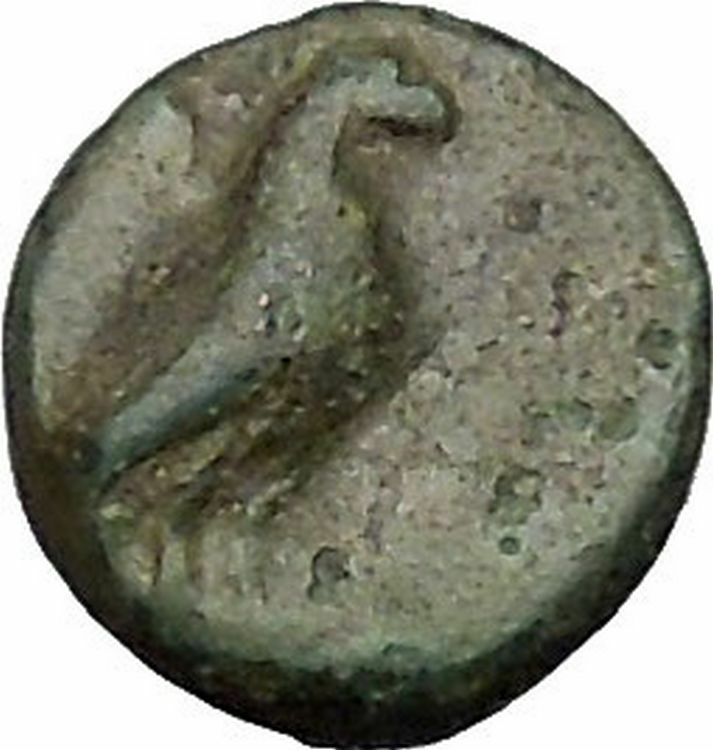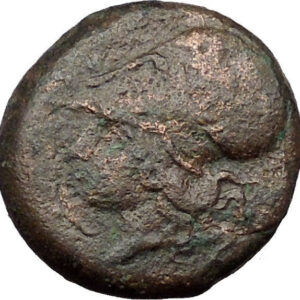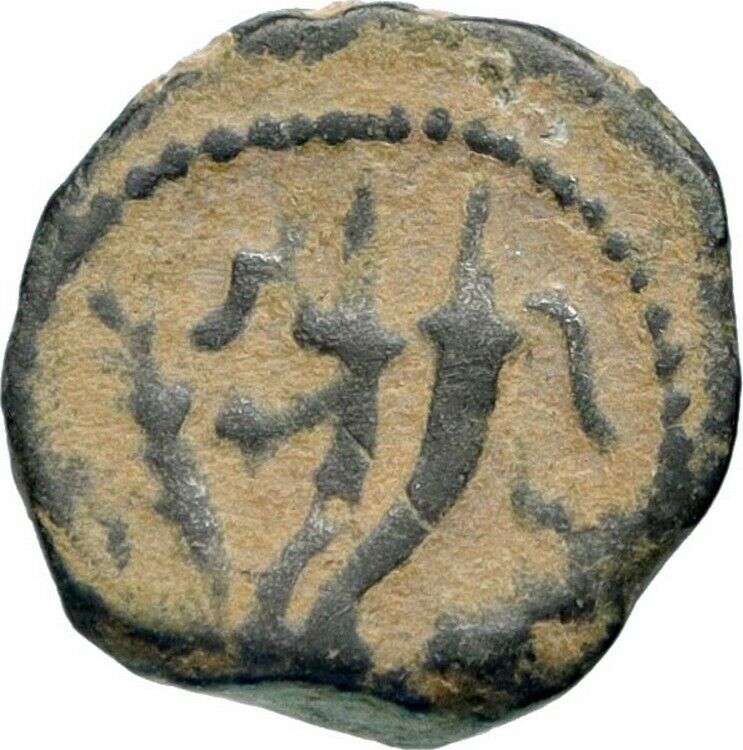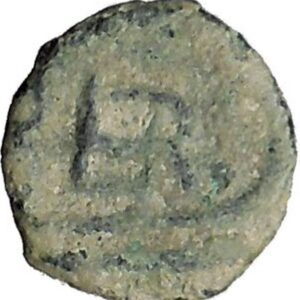|
SELEUKID KINGDOM
Antiochos VII, Euergetes (Sidetes) –
King: 138-129 B.C.
Bronze 18mm (5.95 grams) Struck 138-129 B.C.
Reference: Sear 7098
Winged bust of Eros right wreathed with myrtle.
Head-dress of Isis; on right, ΒΑΣΙΛΕΩΣ / ANTIOXOY; on left, EYEPΓETOY; MH
monogram in left field, beneath, crescent and Seleucid date �OP (=174=138 B.C.)
—
Almost alone amongst the later Seleukid monarchs, ANtiochos
VII ruled with competence and integrity. He was the younger borther of Demetrios
II, and following the latter’s capture by the Parthians he seized power and
quickly disposed of the usurper Tryphon. He campaiged with success in Palestine
and Babylonia, but in 129 B.C. he was killed in battle against the Parthians.
You are bidding on the exact item pictured,
provided with a Certificate of Authenticity and Lifetime Guarantee of
Authenticity.
In
Roman mythology
,
Cupid (Latin cupido,
meaning “desire”) is the god of desire, affection and
erotic
love. He is often portrayed as the son of the goddess
Venus
, with a father rarely mentioned. His
Greek counterpart
is
Eros. Cupid is also known in Latin as Amor (“Love”). The
Amores (plural) or amorini in the later terminology of
art history
are the equivalent of the Greek
Erotes
.
Although Eros appears in
Classical
Greek art
as a slender winged youth, during the
Hellenistic period
he was increasingly
portrayed as a chubby boy. During this time, his iconography acquired the bow
and arrow that remain a distinguishing attribute; a person, or even a deity, who
is shot by Cupid’s arrow is filled with uncontrollable desire. The Roman Cupid
retains these characteristics, which continue in the depiction of multiple
cupids in both
Roman art
and the later
classical tradition
of
Western art
.
Cupid’s ability to compel love and desire plays an instigating role in
several myths or literary scenarios. In
Vergil
‘s
Aeneid
, Cupid prompts
Dido
to fall in love with
Aeneas
, with tragic results.
Ovid makes Cupid the patron of love poets. Cupid is a central
character, however, in only the traditional tale of
Cupid and Psyche
, as told by
Apuleius
.
Cupid was a continuously popular figure in the
Middle Ages
, when under Christian influence he
often had a dual nature as Heavenly and Earthly love, and in the
Renaissance
, when a renewed interest in
classical philosophy endowed him with complex allegorical meanings. In
contemporary popular culture, Cupid is shown shooting his bow to inspire
romantic love, often as an icon of
Valentine’s Day
.
Legend
In the Roman version, Cupid was the son of Venus (goddess of hope) and Mars
(god of war).[2][3]
In the Greek version he was named
Eros and seen as one of the
primordial gods
(though other myths exist as
well). Cupid was often depicted with wings, a bow, and a quiver of arrows. The
following story of
Cupid and Psyche
is almost identical in both
cultures; the most familiar version is found in the
Metamorphoses
of
Apuleius
. When Cupid’s mother Venus became
jealous of the princess
Psyche
, who was so beloved by her subjects that
they forgot to worship Venus, she ordered Cupid to make Psyche fall in love with
the vilest thing in the world. While Cupid was sneaking into her room to shoot
Psyche with a golden arrow, he accidentally scratched himself with his own arrow
and fell deeply in love with her.
Following that, Cupid visited Psyche every night while she slept. Speaking to
her so that she could not see him, he told her to never try to see him. Psyche,
though, incited by her two older sisters who told her Cupid was sparcker [a
monster], tried to look at him and angered Cupid. When he left, she looked all
over the known world for him until at last Venus told her that she would help
her find Cupid if she did the tasks presented to her by Venus. Psyche agreed.
Psyche completed every task presented to her, each one harder than the last.
Finally, Venus had one task left – Psyche had to give Pluto a box containing
something Psyche was not to look at. Psyche’s curiosity got the best of her and
she looked in the box. Hidden within it was eternal sleep placed there by Venus.
Cupid was no longer angered by Psyche and brought her from her sleep. Jupiter,
the leader of the gods, gave Psyche the gift of immortality so that she could be
with him. Together they had a daughter,
Voluptas
, or
Hedone
, (meaning pleasure) and Psyche became a
goddess. Her name “Psyche” means “soul.”
Portrayal
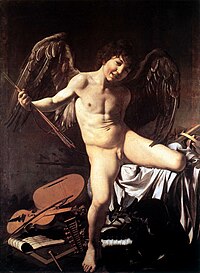
Caravaggio
‘s
Amor Vincit Omnia
In painting and sculpture, Cupid is often portrayed as a
nude
(or sometimes
diapered
) winged boy or baby (a
putto
) armed with a bow and a quiver of arrows.
On gems and other surviving pieces, Cupid is usually shown amusing himself
with adult play, sometimes driving a hoop, throwing darts, catching a butterfly,
or flirting with a nymph
. He is often depicted with his mother (in
graphic arts, this is nearly always Venus), playing a horn. In other images, his
mother is depicted scolding or even spanking him due to his mischievous nature.
He is also shown wearing a helmet and carrying a buckler, perhaps in reference
to Virgil
‘s Omnia vincit amor or as
political satire
on wars for love or love as
war.
Cupid figures prominently in
ariel poetry
, lyrics and, of course,
elegiac
love and
metamorphic poetry
. In epic poetry, he is less
often invoked, but he does appear in
Virgil
‘s
Aeneid
changed into the shape of
Ascanius
inspiring
Dido’s
love. In later literature, Cupid is
frequently invoked as fickle, playful, and perverse. He is often depicted as
carrying two sets of arrows: one set gold, which inspire true love; and the
other lead-headed, which inspire erotic love.
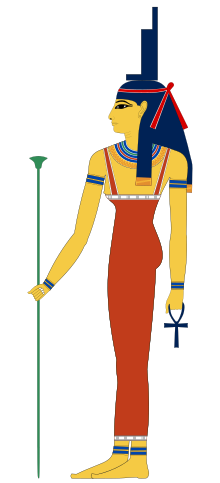
The goddess Isis portrayed as a woman, wearing a headdress shaped
like a throne and with an Ankh in her hand
Isis (Ancient
Greek: Ἶσις, original
Egyptian
pronunciation more likely Aset)
is a goddess in
Ancient Egyptian
religious beliefs
, whose worship spread
throughout the
Greco-Roman world
. She was worshipped as the
ideal mother and wife as well as the patroness of nature and magic. She was the
friend of
slaves
,
sinners,
artisans
, and the downtrodden, and she listened
to the prayers of the wealthy, maidens, aristocrats, and rulers.Isis is often
depicted as the mother of
Horus
, the hawk-headed god of war and
protection (although in some traditions Horus’s mother was
Hathor
). Isis is also known as protector of the
dead and goddess of children.
The name Isis means “Throne”.Her headdress is a throne. As the
personification of the throne, she was an important representation of the
pharaoh’s power. The pharaoh was depicted as her child, who sat on the throne
she provided. Her
cult
was popular throughout Egypt, but her most
important
temples
were at Behbeit El-Hagar in the
Nile delta
, and, beginning in the reign with
Nectanebo I (380–362 BCE), on the island of
Philae
in Upper Egypt.
In the typical form of her myth, Isis was the first daughter of
Geb,
god of the Earth, and
Nut
, goddess of the Sky, and she was born on
the fourth
intercalary day
. She married her brother,
Osiris
, and she conceived Horus with him. Isis
was instrumental in the resurrection of Osiris when he was murdered by
Set
. Using her magical skills, she restored his
body to life after having gathered the body parts that had been strewn about the
earth by Set.
This myth became very important during the Greco-Roman period. For example it
was believed that the
Nile River
flooded every year because of the
tears of sorrow which Isis wept for Osiris. Osiris’s death and rebirth was
relived each year through rituals. The worship of Isis eventually spread
throughout the Greco-Roman world, continuing until the suppression of
paganism
in the Christian era.The popular motif
of Isis suckling her son Horus, however, lived on in a Christianized context as
the popular image of Mary suckling the infant son Jesus from the fifth century
onward.
Etymology
The name Isis is the Greek version of her name, with a final -s
added to the original Egyptian form because of the grammatical requirements of
the Greek language (-s often being a marker of the
nominative case
in ancient Greek).
The Egyptian name was recorded as ỉs.t or
È�s.t and meant “(She of the Throne”). The
true Egyptian pronunciation remains uncertain, however, because
hieroglyphs
do not indicate
vowels
. Based on recent studies which present
us with approximations based on contemporary languages (specifically, Greek) and
Coptic
evidence, the reconstructed
pronunciation of her name is *Usat
[*ˈʔy�səʔ]
. Osiris’s name, *Usir
also starts with the throne glyph ʔs.[7]
For convenience,
Egyptologists
arbitrarily choose to pronounce
her name as “ee-set”. Sometimes they may also say “ee-sa” because the final “t”
in her name was a feminine
suffix
, which is known to have been dropped in
speech
during the last stages of the Egyptian
and Greek languages.
Principal
features of the cult
Origins

Isis depicted with outstretched wings (wall painting, c. 1360 BCE)
Most Egyptian deities were first worshipped by very local cults, and they
retained those local centres of worship even as their popularity spread, so that
most major cities and towns in Egypt were known as the home of a particular
deity. The origins of the cult of Isis are uncertain, but it is believed that
she was originally an independent and popular deity in
predynastic
times, prior to 3100 BCE, at
Sebennytos
in the Nile delta.[3]
The first written references to Isis date back to the
Fifth dynasty of Egypt
. Based on the
association of her name with the throne, some early Egyptologists believed that
Isis’s original function was that of throne-mother.[citation
needed] However, more recent scholarship suggests
that aspects of that role came later by association. In many African tribes, the
throne is known as the mother of the king, and that concept fits well
with either theory, possibly giving insight into the thinking of ancient
Egyptians.
Classical Egyptian
period
During the
Old Kingdom
period, Isis was represented as the
wife or assistant to the deceased pharaoh. Thus she had a funerary association,
her name appearing over eighty times in the pharaoh’s funeral texts (the
Pyramid Texts
). This association with the
pharaoh’s wife is consistent with the role of Isis as the spouse of Horus, the
god associated with the pharaoh as his protector, and then later as the
deification of the pharaoh himself.
But in addition, Isis was also represented as the mother of the “four suns of
Horus”, the four deities who protected the
canopic jars
containing the pharaoh’s internal
organs. More specifically, Isis was viewed as the protector of the
liver
-jar-deity,
Imsety
.[8]
By the
Middle Kingdom
period, as the funeral texts
began to be used by members of Egyptian society other than the royal family, the
role of Isis as protector also grew, to include the protection of nobles and
even commoners.[citation
needed]
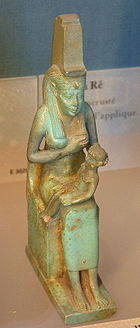
Isis nursing Horus (Louvre)
By the
New Kingdom
period, the role of Isis as a
mother deity had displaced that of the spouse. She was seen as the mother of the
pharaoh, and was often depicted breastfeeding the pharaoh. It is theorized that
this displacement happened through the merging of cults from the various cult
centers as Egyptian religion became more standardized.[citation
needed] When the cult of
Ra
rose to prominence, with its cult center at
Heliopolis
, Ra was identified with the similar
deity, Horus. But Hathor had been paired with Ra in some regions, as the mother
of the god. Since Isis was paired with Horus, and Horus was identified with Ra,
Isis began to be merged with Hathor as Isis-Hathor. By merging with
Hathor, Isis became the mother of Horus, as well as his wife. Eventually the
mother role displaced the role of spouse. Thus, the role of spouse to Isis was
open and in the Heliopolis pantheon, Isis became the wife of Osiris and the
mother of Horus/Ra. This reconciliation of themes led to the evolution of the
myth of Isis and Osiris
.[8]
Temples and priesthood
Little information on Egyptian rituals for Isis survives; however, it is
clear there were both priests and priestesses officiating at her cult throughout
its history. By the Greco-Roman era, many of them were considered
healers
, and were said to have other special
powers, including dream interpretation and the ability to control the
weather
, which they did by braiding or not
combing their hair.[citation
needed] The latter was believed because the
Egyptians considered knots
to have magical powers.
The cult of Isis and Osiris continued up until the 6th century CE on the
island of Philae in Upper Nile. The
Theodosian decree
(in about 380 CE) to destroy
all pagan temples was not enforced there until the time of
Justinian
. This toleration was due to an old
treaty made between the Blemyes-Nobadae and the emperor
Diocletian
. Every year they visited Elephantine
and at certain intervals took the image of Isis up river to the land of the
Blemyes for
oracular
purposes before returning it.
Justinian sent Narses
to destroy the sanctuaries, with the
priests being arrested and the divine images taken to Constantinople.[9]
Philae
was the last of the ancient Egyptian
temples to be closed.
Iconography
Associations
Due to the association between knots and magical power, a symbol of Isis was
the tiet or tyet
(meaning welfare/life),
also called the Knot of Isis, Buckle of Isis, or the
Blood
of Isis, which is shown to the right.
In many respects the tyet resembles an
ankh, except that its arms point downward, and when used as such,
seems to represent the idea of
eternal life
or
resurrection
. The meaning of Blood of Isis
is more obscure, but the tyet often was used as a funerary
amulet
made of red
wood,
stone
, or
glass
, so this may simply have been a
description of the appearance of the materials used.
The star Sopdet
(Sirius)
is associated with Isis. The appearance of the star signified the advent of a
new year and Isis was likewise considered the goddess of rebirth and
reincarnation, and as a protector of the dead. The Book of the Dead outlines a
particular ritual that would protect the dead, enabling travel anywhere in the
underworld, and most of the titles Isis holds signify her as the goddess of
protection of the dead.
Probably due to assimilation with the goddess Aphrodite (Venus),
during the Roman period, the
rose was used in her worship. The demand for roses throughout the
empire turned rose production into an important industry.
Depictions
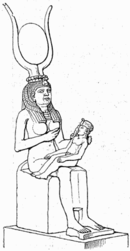
Isis nursing
Horus
, wearing the headdress of
Hathor
.
In art, originally Isis was pictured as a woman wearing a long sheath dress
and crowned with the
hieroglyphic
sign for a throne.
Sometimes she is depicted as holding a
lotus
, or, as a
sycamore
tree. One pharaoh,
Thutmose III
, is depicted in his tomb as
nursing from a sycamore tree that had a breast.
After she assimilated many of the roles of Hathor, Isis’s headdress is
replaced with that of Hathor: the horns of a cow on her head, with the solar
disk between them. Sometimes she also is represented as a cow, or a cow’s head.
Usually, however, she is depicted with her young child, Horus (the pharaoh),
with a
crown
, and a
vulture
. Occasionally she is represented as a
kite
flying above the body of Osiris or with
the dead Osiris across her lap as she worked her magic to bring him back to
life.
Most often Isis is seen holding only the generic
ankh sign and a simple staff, but in late images she is seen
sometimes with items usually associated only with Hathor, the sacred
sistrum
rattle and the fertility-bearing
menat
necklace
. In
The Book of Coming Forth By Day
Isis is
depicted standing on the prow of the
Solar Barque
with her arms outstretched.[1]
Mythology
Sister-wife to Osiris
During the
Old Kingdom
period, the pantheons of individual
Egyptian cities varied by region. During the
5th dynasty
, Isis entered the pantheon of the
city of
Heliopolis
. She was represented as a daughter
of Nut and Geb, and sister to Osiris,
Nephthys
, and Set. The two sisters, Isis and
Nephthys, often were depicted on coffins, with wings outstretched, as protectors
against evil. As a funerary deity, she was associated with Osiris, lord of the
underworld, and was considered his wife.

Rare
terracotta
image of Isis lamenting
the loss of Osiris (eighteenth dynasty)
Musée du Louvre
,
Paris
.
A later myth, when the cult of Osiris gained more authority, tells the story
of Anubis
, the god of the underworld. The tale
describes how Nephthys was denied a child by Set and disguised herself as the
much more attractive Isis to seduce him. The plot failed, but Osiris now found
Nephthys very attractive, as he thought she was Isis. They
had sex
, resulting in the birth of Anubis.
Alternatively, Nephthys intentionally assumed the form of Isis in order to trick
Osiris into fathering her son.
In fear of Set’s retribution, Nephthys persuaded Isis to adopt Anubis, so
that Set would not find out and kill the child. The tale describes both why
Anubis is seen as an underworld deity (he becomes a son of Osiris), and why he
could not inherit Osiris’s position (he was not a legitimate heir in this new
birth scenario), neatly preserving Osiris’s position as lord of the underworld.
It should be remembered, however, that this new myth was only a later creation
of the Osirian cult who wanted to depict Set in an evil position, as the enemy
of Osiris.
The most extensive account of the Isis-Osiris story known today is Plutarch’s
Greek description written in the 1st century CE, usually known under its Latin
title De Iside et Osiride.[11]
In that version, Set held a banquet for Osiris in which he brought in a
beautiful box and said that whoever could fit in the box perfectly would get to
keep it. Set had measured Osiris in his sleep and made sure that he was the only
one who could fit the box. Several tried to see whether they fit. Once it was
Osiris’s turn to see if he could fit in the box, Set closed the lid on him so
that the box was now a coffin for Osiris. Set flung the box in the Nile so that
it would drift far away. Isis went looking for the box so that Osiris could have
a proper burial. She found the box in a tree in
Byblos
, a city along the Phoenician coast, and
brought it back to Egypt, hiding it in a swamp. But Set went hunting that night
and found the box. Enraged, Set chopped Osiris’s body into fourteen pieces and
scattered them all over Egypt to ensure that Isis could never find Osiris again
for a proper burial.[12][13]
Isis and her sister Nephthys went looking for these pieces, but could only
find thirteen of the fourteen. Fish had swallowed the last piece, his
phallus
, so Isis made him a new one with magic,
putting his body back together after which they conceived Horus. The number of
pieces is described on temple walls variously as fourteen and sixteen, and
occasionally
forty-two
, one for each
nome
or district.[13]
Mother of Horus
Yet another set of late myths detail the adventures of Isis after the birth
of Osiris’s posthumous son,
Horus
. Isis was said to have given birth to
Horus at Khemmis, thought to be located on the Nile Delta.[14]
Many dangers faced Horus after birth, and Isis fled with the newborn to escape
the wrath of
Set
, the murderer of her husband. In one
instance, Isis heals Horus from a lethal scorpion sting; she also performs other
miracles in relation to the
cippi
, or the plaques of Horus. Isis
protected and raised Horus until he was old enough to face Set, and
subsequently, became the pharaoh of Egypt.
Magic
It was said that Isis tricked
Ra
(i.e. Amun-Ra/Atum-Ra) into telling her his “secret name,” by
causing a
snake
to bite him, for which only Isis had the
cure. Knowing the secret name of a deity enabled one to have power of the deity.
The use of secret names became central in late Egyptian magic spells, and Isis
often is implored to “use the true name of Ra” in the performance of rituals. By
the late Egyptian historical period, after the occupations by the Greeks and the
Romans, Isis became the most important and most powerful deity of the Egyptian
pantheon because of her magical skills.
Magic
is central to the entire mythology of
Isis, arguably more so than any other Egyptian deity.
Isis had a central role in Egyptian magic spells and ritual, especially those
of protection and healing. In many spells, she also is completely merged even
with Horus, where invocations of Isis are supposed to involve Horus’s powers
automatically as well. In Egyptian history the image of a wounded Horus became a
standard feature of Isis’s healing spells, which typically invoked the curative
powers of the milk of Isis.
Greco-Roman world
Interpretatio graeca
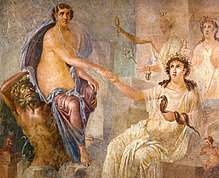
Isis (seated right) welcoming the
Greek heroine
Io
as she is borne into Egypt on
the shoulders of the personified Nile, as depicted in a Roman wall
painting from
Pompeii
Using the comparative methodology known as
interpretatio graeca
, the Greek historian
Herodotus
(5th century BCE) described Isis by
comparison with the Greek goddess
Demeter
, whose
mysteries
at
Eleusis
offered initiates guidance in the
afterlife and a vision of rebirth. Herodotus says that Isis was the only goddess
worshiped by all Egyptians alike.[16]

Terracotta figure of Isis-Aphrodite from
Ptolemaic Egypt
After the conquest of Egypt by
Alexander the Great
and the
Hellenization
of the Egyptian culture initiated
by
Ptolemy I Soter
, Isis became known as
Queen of Heaven
.[17]
Other Mediterranean goddesses, such as Demeter,
Astarte
, and
Aphrodite
, became identified with Isis, as was
the Arabian goddess Al-Ozza or Al-Uzza through a similarity
of name, since etymology was thought to reveal the essential or primordial
nature of the thing named.[18]
An alabaster statue of Isis from the 3rd century BCE, found in
Ohrid
, in the
Republic of Macedonia
, is depicted on the
obverse
of the Macedonian 10
denars
banknote, issued in 1996.[19]
Isis in the Roman
Empire

Roman Isis holding a sistrum and
oinochoe
and wearing a garment tied
with a characteristic knot, from the time of
Hadrian
(117–138 CE)
Tacitus
writes that after the
assassination of Julius Caesar
, a temple in
honour of Isis had been decreed, but was suspended by Augustus as part of his
program to restore
traditional Roman religion
. The emperor
Caligula
, however, was open to Eastern
religions, and the
Navigium Isidis
, a procession in honor of
Isis, was established in Rome during his reign.[20]
According to the Jewish historian
Josephus
, Caligula donned female garb and took
part in the mysteries he instituted.
Vespasian
, along with
Titus
, practised
incubation
in the Roman
Iseum
.
Domitian
built another Iseum along with a
Serapeum
. In a
relief
on the
Arch of Trajan
, the emperor appears before Isis
and Horus, presenting them with votive offerings of wine.[20]
Hadrian
decorated his villa at
Tibur
with Isiac scenes.
Galerius
regarded Isis as his protector.[21]
The religion of Isis thus spread throughout the
Roman Empire
during the formative centuries of
Christianity. Wall paintings and objects reveal her pervasive presence at
Pompeii
, preserved by the
eruption of Vesuvius
in 79 CE. In Rome, temples
were built and obelisks erected in her honour. In Greece, the cult of Isis was
introduced to traditional centres of worship in
Delos
,
Delphi
,
Eleusis
and
Athens
, as well as in northern Greece. Harbours
of Isis were to be found on the Arabian Sea and the Black Sea. Inscriptions show
followers in Gaul, Spain, Pannonia, Germany, Arabia, Asia Minor, Portugal and
many shrines even in Britain.[22]
Tacitus interprets a goddess among the Germanic
Suebi
as
a form of Isis
whose symbol (signum) was
a ship.[23]
Bruce Lincoln
regards the identity of this
Germanic goddess as “elusive.”[24]
The Greek antiquarian
Plutarch
wrote a treatise on Isis and Osiris,[25]
a major source for Imperial theology concerning Isis.[11]
Plutarch describes Isis as “a goddess exceptionally wise and a lover of wisdom,
to whom, as her name at least seems to indicate, knowledge and understanding are
in the highest degree appropriate… .” The statue of Athena in
Sais
was identified with Isis, and according to
Plutarch was inscribed “I am all that has been, and is, and shall be, and my
robe no mortal has yet uncovered.”[26]
At Sais, however, the patron goddess of the ancient cult was
Neith
, many of whose traits had begun to be
attributed to Isis during the Greek occupation.
The Roman writer
Apuleius
recorded aspects of the cult of Isis
in the 2nd century CE, including the Navigium Isidis, in his novel
The Golden Ass
. The protagonist Lucius
prays to Isis as Regina Caeli, “Queen of Heaven”:
You see me here, Lucius, in answer to your prayer. I am nature, the
universal Mother, mistress of all the elements, primordial child of
time, sovereign of all things spiritual, queen of the dead, queen of the
ocean, queen also of the immortals, the single manifestation of all gods
and goddesses that are, my nod governs the shining heights of Heavens,
the wholesome sea breezes. Though I am worshipped in many aspects, known
by countless names … the Egyptians who excel in ancient learning and
worship call me by my true name…Queen Isis.[27]

Ruins of the Temple of Isis in Delos
According to Apuleius, these other names include manifestations of the
goddess as
Ceres
, “the original nurturing parent”;
Heavenly Venus (Venus Caelestis); the “sister of
Phoebus
“, that is, Diana or
Artemis
as she is
worshipped at Ephesus
; or
Proserpina
(Greek
Persephone
) as the triple goddess of the
underworld.[28]
From the middle Imperial period, the title Caelestis, “Heavenly” or
“Celestial”, is attached to several goddesses embodying aspects of a single,
supreme Heavenly Goddess. The Dea Caelestis was identified with the
constellation Virgo (the Virgin)
, who holds the
divine balance of justice
.
Greco-Roman temples
On the Greek island of
Delos
a
Doric
Temple of Isis was built on a high
over-looking hill at the beginning of the Roman period to venerate the familiar
trinity of Isis, the Alexandrian
Serapis
and
Harpocrates
. The creation of this temple is
significant as Delos is particularly known as the birthplace of the Greek gods
Artemis
and
Apollo
who had temples of their own on the
island long before the temple to Isis was built.
In the Roman Empire, a well-preserved example was discovered in
Pompeii
.The only sanctuary of Isis (fanum
Isidis) identified with certainty in
Roman Britain
is located in
Londinium
(present-day London).[29]

Isis in black and white marble (Roman, 2nd century CE)
Late antiquity
The cult of Isis was part of the
syncretic
tendencies of religion in the
Greco-Roman world of
late antiquity
. The male first name “Isidore”
in Greek means “gift of Isis” (similar to “Theodore“,
“God’s gift”).
The Isis cult in Rome was a template for the Christian
Madonna
cult.
![Eros1st c. BCE marble from Pompeii. This statue is also known as Eros Centocelle, and is thought to be a copy of the colossal Eros of Thespiae, a work by Praxiteles.[1]](https://upload.wikimedia.org/wikipedia/commons/thumb/c/c3/Eros_Farnese_MAN_Napoli_6353.jpg/150px-Eros_Farnese_MAN_Napoli_6353.jpg)
Antiochus VII Euergetes, nicknamed Sidetes
(from Side
), ruler
of the
Hellenistic
Seleucid Empire
, reigned from 138 to 129 BC. He was the last Seleucid king
of any stature.
The brother of
Demetrius II
, Antiochus was elevated after Demetrius’ capture by the
Parthians
. He
married
Cleopatra Thea
, who had been the wife of Demetrius. Their offspring was
Antiochus IX
, who thus became both half-brother and cousin to
Seleucus V
and
Antiochus VIII
.
Sidetes defeated the usurper
Tryphon
at
Dora
[1]
and laid siege to
Jerusalem
in 134. According to
Josephus
[2]
the Hasmonean
king John Hyrcanus
opened King
David
‘s sepulchre
and removed three thousand talents, which he then paid Antiochus to spare the
city. Sidetes then attacked the Parthians, supported by a body of Jews under
Hyrcanus, and briefly took back
Mesopotamia
,
Babylonia
and Media
before
being ambushed and killed by
Phraates II
. His brother
Demetrius II
had by then been released, but the Seleucid realm was now
restricted to Syria
.
|








![Q1 [st] st](https://i0.wp.com/bits.wikimedia.org/static-1.22wmf3/extensions/wikihiero/img/hiero_Q1.png?w=1200&ssl=1)
![X1 [t] t](https://i0.wp.com/bits.wikimedia.org/static-1.22wmf3/extensions/wikihiero/img/hiero_X1.png?w=1200&ssl=1)


![Z4 [y] y](https://i0.wp.com/bits.wikimedia.org/static-1.22wmf3/extensions/wikihiero/img/hiero_Z4.png?w=1200&ssl=1)










![Eros1st c. BCE marble from Pompeii. This statue is also known as Eros Centocelle, and is thought to be a copy of the colossal Eros of Thespiae, a work by Praxiteles.[1]](https://upload.wikimedia.org/wikipedia/commons/thumb/c/c3/Eros_Farnese_MAN_Napoli_6353.jpg/150px-Eros_Farnese_MAN_Napoli_6353.jpg)
